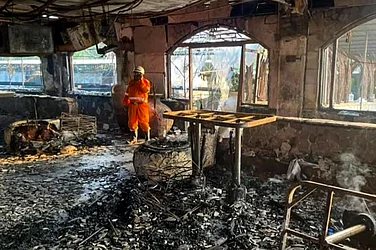For the past few days, several parts of Delhi have been submerged in flooding not seen in decades.
The record waterlogging in Delhi has come with days of heavy rainfall, clogged drains, and a Yamuna water level that touched 45-year-high.
Elite neighbourhoods like the Civil Lines were also submerged and the memorial Raj Ghat was also taken over by the swollen Yamnua.
Even as the Aam Aadmi Party (AAP) claimed that the Delhi floods were a result of a conspiracy hatched by the Bharatiya Janata Party (BJP), the independent experts said that several decades of systemic encroachment of the Yamuna floodplains and flawed governmental development projects have led us to the current situation.
Here we explain what are floodplains, what the issues are with Yamuna floodplains in Delhi, and what the experts have said.
What are floodplains?
A floodplain is an area adjacent to a river or a stream that's subject to inundation whenever the river swells up, such as during the rainy season. It is part of the riverine ecosystem and disturbance with it has the potential of adverse ecological effects.
Floodplains have a distinct ecological role in the region they are located in. The National Geographic Society notes, "Floodplains have dazzling arrays of biodiversity. These seasonal riparian wetlands boast greater biodiversity than the rivers themselves."
The Nat Geo Society noted that humans have settled around floodplains since ancient times as the area has fertile soil that supports agriculture, provides riverine transportation, and has availability of drinking water for housing and businesses.
However, experts say the human habitation along the rivers has to take into account the natural balance of the region and also the reality that the floodplains are the natural flood outlets of the river. When it rains, that region will be inundated. If humans settle they're unregulated there, then life, livelihood, infrastructure, and the natural ecosystem are all at risk.
"By retaining water, floodplains can buffer the effects of heavy rainfall and in this way protect economic activities and communities further downstream from flood damage. However, many former natural floodplains are under increased pressure from urban sprawl, infrastructure developments and agriculture," says the Europe Environmental Agency in a report, further nothing that floodplains naturally provide flood risk reduction and favour a high biodiversity.
Yamuna floodplains and Delhi floods
Yamuna in Delhi this year reached the highest water-level in more than five decades.
The Yamuna river water reached the peak 208.66 metres at 8 pm on Thursday. It has come since but still remains above the danger level of 205.33 metres. As of 1 pm on Sunday, the Yamuna water level stood at 205.85 metres.
The clogged drains and jammed gates of barrages stopping the flow of water out of Delhi combined with the record rainfall in Delhi to turn large parts of the national capital into a pool. Scenes of the people swimming on the roads of Delhi resembling canals and some even coming out with inflatable tubs and tubes on flooded streets dominated the social media feed for days.
Amid such scenes, decades of encroachment and damage to Yamuna floodplains have come under a scrutiny.
Former Delhi Development Authority (DDA) Commissioner AK Jain told NDTV that Delhi's first developmental masterplan in 1962 did a "mistake" by considering the Delhi's floodplains as "empty lot". As a result, reports NDTV, numerous infrastructural projects were carried out on Yamuna floodplains, including a ring road, power stations, and Indira Gandhi indoor stadium, the Delhi secretariat, a Delhi Transport Corporation (DTC) Depot, and landfills.
A report in Millennium Post cites environmentalists as saying that up to 40 per cent of floodplains have been lost to such activities over the past four decades.
Activists have proposed corrective steps like building bird parks, botanical parks, and lakes, but the Post report says such steps have not been taken.
Experts have said that the natural flow of Yamuna has been altered over several decades by flawed developmental projects. A report said that Edwin Lutyens recognised this and that's why the British centre of power in Delhi was constructed at the elevated Raisina Hill and the surrounding area called Lutyens Delhi.
Manu Bhatnagar, an environmental planner who heads the Natural Heritage Division of Intach, told Hindustan Times that Yamuna was jacketed by embankments in the 20th century.
He said, "Before embankments, the space for the river was wide in scope. The river reached the walls of the Red Fort; it used to flow where we have the Ring Road today...East Delhi, for instance, was Jamuna paar, a doab region between the Hindon and the Yamuna. But with the left and the right main embankments, the river was jacketed, confining it to a limited space where high discharge does not dissipate horizontally but rises vertically, preventing urban stormwater from emptying into the river. If you go against the topography, this (flooding) is bound to happen."
As the natural flood outlet of the Yamuna has been systemically encroached over the decades, the flooding of colonies and public buildings in the area is just natural.
"The low-lying areas near the river in Delhi, inhabited by around 41,000 people, are considered prone to flooding. Encroachments on the river floodplain have occurred over the years, despite the land belonging to the Delhi Development Authority, the revenue department and private individuals," reported PTI


























